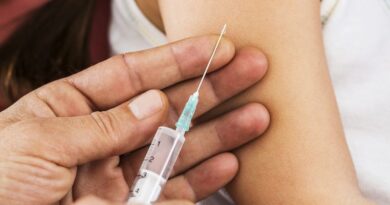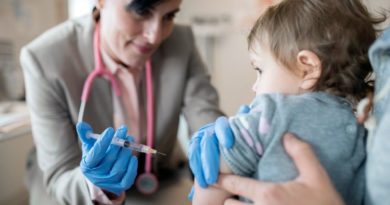Anti-vaxxers are now after your dog

Here we are, coming up on three years of dealing with COVID, and not only are people still arguing about vaccines against the disease, but the anti-vax sentiment that seemed to blossom when the COVID vaccine became available in 2021 has also now cross-pollinated and found its way into the veterinary clinic. A study just published by the journal Vaccine, part of the ScienceDirect network, showed that more than half of American respondents now have questions about vaccinating their dogs – even against rabies.
The Vaccine study, done in conjunction with YouGov, the public opinion polling outfit, questioned 2,200 Americans between March 30 and April 10 of this year and found that 53 percent of respondents had what the study called some “hesitancy” about vaccinating their dogs. This is a bigger problem than you’d think. According to the journal Frontiers in Veterinary Science, 99 percent of all rabies cases worldwide are contracted through dogs that are household pets. Even scarier than that, rabies is almost always fatal once dogs or humans show symptoms. It’s a vicious disease; vaccinating dogs is the best way to control it. Given those figures, you’d think that vaccinations for dogs would be a slam dunk, wouldn’t you?
Think again.
According to the poll by Vaccine/YouGov, large numbers of the American population believe that canine vaccines are unsafe (37 percent), ineffective (22 percent), or unnecessary (30 percent.) According to the study, “A slight majority of dog owners (53 percent) endorse at least one of these three positions.”
Where the hell did that come from, you might ask? According to Bloomberg, “Nearly 40 percent were concerned that vaccines could cause dogs to develop autism, a theory without any scientific merit.” Sound familiar? We’ve got a prospective presidential candidate, Robert F. Kennedy Jr., who has been pushing that nonsense about humans for the last couple of decades. That the same bogus theory has now invaded the vet’s office shows you how far we’ve fallen as a nation when it comes to taking care of not only ourselves and our children, but even our pets.
Dogs are like kids in the sense that they don’t get a vote when it comes to their health. Dogs don’t ask you to put them in the car and drive them to the vet to get their shots for rabies or parvovirus, diseases that when contracted by dogs or cats can be fatal. Neither do your kids ask you to get them vaccinated against measles, mumps and rubella, or polio, or whooping cough. We take…or maybe I should say took…this stuff for granted for so long, the whole childhood vaccine thing just dropped off the radar, at least until COVID, when paranoid right-wing lunatics and certain people with the last name “Kennedy” started beating the discredited drum that somehow childhood vaccines do more harm than good.
You tend to forget how extraordinary it is that medical science has been able to develop ways of immunizing us against these brutal childhood diseases.
Let’s take a look at whooping cough, just for one example. I’m old enough to have been alive when whooping cough went around in schools, as they used to say. Living close together, you could hear kids through the walls as you climbed the stairs to your apartment whooping, which is a very good word to describe the initial symptoms of the disease. Kids used to emit this strange wheeze accompanied by a violent intake of breath, causing the whoop sound. The disease was easily transmissible, and I can remember schools being shut down when there was a serious outbreak.
Why? Because a quarter of the kids came down with pneumonia, a disease that could be deadly even after the discovery of antibiotics like penicillin. I remember seeing photographs of a ward in a hospital in which ten kids lay on beds under big oxygen tents, coughing and whooping. Some kids developed convulsions and shook uncontrollably. Many kids had apnea, causing them not to sleep restfully, or even to wake up suddenly, not being able to get a breath.
And then there was polio, the most frightening disease of them all when I was a kid. For the first four years of my schooling, every class I was in had at least one kid who walked with crutches or was bent over from the debilitating effects of the disease, or was in a wheelchair. There were scary photos in LIFE magazine of hospital wards the size of basketball courts filled with kids in iron lungs being attended to by nurses in starched uniforms. In 1954, when I was in the second grade in an elementary school at Fort Leavenworth, Kansas, there was a polio outbreak.80 kids came down with polio within the first two months of the school year. It was the army, of course, and it was a time when parents didn’t yank their kids out of school and schools themselves weren’t closed because of an outbreak of a disease, even polio. Instead, they lined us up in the hallways and gave us shots of gamma globulin to boost our immune systems. The stuff had the consistency of motor oil and was given with a needle about four inches long. I can still remember standing in my school hallway listening through the doorway to kids screaming as the shots were administered.
Want a daily wrap-up of all the news and commentary Salon has to offer? Subscribe to our morning newsletter, Crash Course.
By the time the first trial of the Salk vaccine began in 1954, the polio outbreak at Fort Leavenworth had gotten so bad that they dropped the placebo from the test and just gave all of us the Salk vaccine shots. It stopped the outbreak, but I had nightmares about the gamma-globulin shots for years.
You tend to forget how extraordinary it is that medical science has been able to develop ways of immunizing us against these brutal childhood diseases. At least I did, until I was in Afghanistan as a reporter in 2004 and traveled to Asadabad, an outlaw town on the Afghan-Pakistan border in the foothills of the Himalayas. Taliban control of the surrounding area on both sides of the border had prevented NGOs from setting up health clinics and vaccinating the local populace. So polio was rampant in mountain villages, and driving into Asadabad, you could see the effects of it right out on the street. Kids hobbled past on crutches made from “Y” shaped tree branches that had been cut down to fit their tiny bodies. Old men, begging for handouts, pushed themselves with bits of wood held in their hands down dirt streets on boards with wheels from shopping carts. There weren’t any antibiotics available, either, so staph infection was rampant – leaving little girls with oozing sores on their legs and boys with pus-filled open wounds on their necks.
We take the stuff about our own health for granted, until we’re brought up short by a disease like COVID. It was only two years ago when so many of our fellow citizens were lined up in refrigerated trucks outside of hospitals too busy to handle the bodies being carried out of emergency rooms and ICUs.
Even when those memories fade, we’re reminded again of the folly of human beings when a new study comes out like the one showing that the anti-vax mania has now spread into veterinary offices.
I didn’t have a column in Salon two Saturdays ago because my wife Tracy and I came down with mild cases of COVID, despite our triple-vaccinated and double-boosted status. I looked up the figures showing what they’re calling an “uptick” of COVID cases around the country. In my state, Pennsylvania, hospitalizations are up 19 percent over the last two weeks. In the same time period, COVID deaths increased 45 percent. Nationally, COVID hospitalizations are up 31 percent with deaths up 32 percent over the past two weeks.
Vaccination rates and the spread of at least two new variants of COVID show why these increases are happening. Nationally, the rate for primary COVID vaccinations is 69 percent overall and 94 percent for those over 65 years old. But the rates for bivalent boosters — which work against a variant of the disease that is now at least a year old — is 17 percent among the total U.S. population, and 43 percent among those 65 and older. Tracy and I came down with the disease even though our upper arms look like pincushions by now. But it’s pretty clear that those who are unvaccinated, or only minimally vaccinated, are contributing to the so-called uptick of both hospitalizations and deaths.
So don’t listen to whatever-his-first-name-is Kennedy and the raging lunatics who are still out there screaming that more people are dying from the vaccine than the disease itself. They’re wrong, of course. So please listen to your vet when he or she tells you it’s time to get your dog or cat boosted for rabies. You don’t want to die, and your animals don’t want to die, either. What stands between you and them and any number of diseases that can put either of you in the hospital and start costing you some real money, not to mention your lives, is as ever, a vaccination just like the ones that have been saving lives around the globe for the last 75 years. Don’t hesitate. Do it.
Read more
about the ongoing threat from COVID


